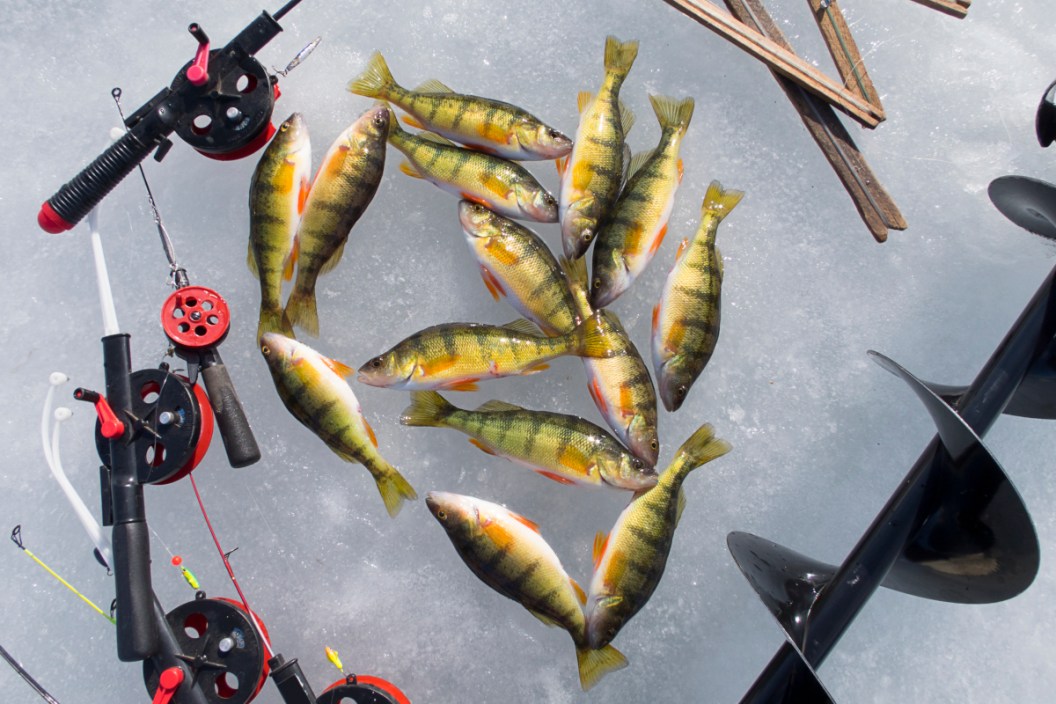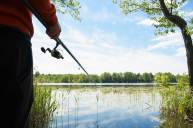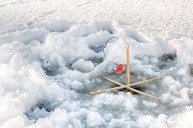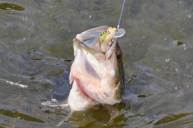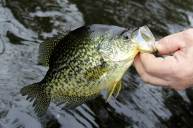Perch ice fishing can make for some excellent winter action.
The best way to beat the blues of hunting season being over and the spring being so far away is to head out on the hardwater for some ice fishing. The good news is that right now is prime time for targeting panfish like bluegills and crappie through the ice. While the fishing for these species is usually good in most northern fisheries, this is probably the best time of year to catch jumbo perch.
Because once you get into a school of active fish, you'll forget all about how cold it is outside. Because the action is usually fast and furious with yellow perch through the ice.
Today we'll examine all aspects of how to catch perch through the ice, from the depth you should be fishing to the types of fishing tackle you should pack. Using these ice fishing tips, you should be able to catch more perch this season fill up your freezer with some delicious filets that should tide you over until the warmer weather finally returns.
Equipment for ice fishing perch.
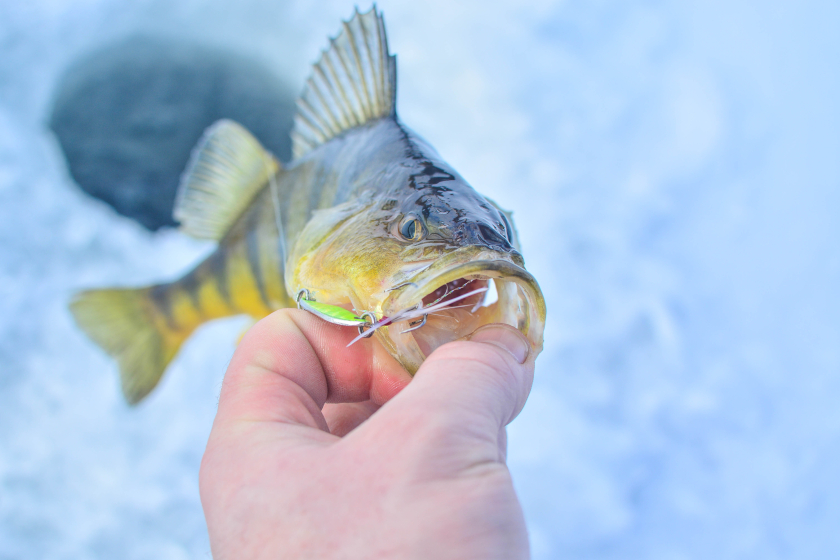
Getty Images: michaldziki
The good news is that anglers do not need anything too fancy to target perch in the winter months. Just about any light ice fishing rods and reels will work. Most prefer to use a spinning setup built for jigging. Something with a flexible rod tip may be preferred because some yellow perch tend to strike without a lot of movement, making it harder to detect strikes. Some anglers like to keep a medium action rod handy for targeting larger perch in deeper water. Most anglers usually use a line between two and four-pound test though. You can use literally any type of line from mono to fluorocarbon. These days many anglers prefer the latter to the former simply because it's a little more sensitive for those light perch strikes we mentioned earlier.
Let's talk about the best ice fishing lures for perch. Remember that perch are a visual hunter, which is why many anglers love to use flashy spoons. For early season perch, they're the preferred lure of choice. Brands like Northlands, Blue Fox, Lindy's, Johnson, and Mepp's all make quality jigging spoons in a variety of colors that are suitable for perch. When selecting colors think about what species of minnows or baitfish might be present where you're fishing and try to match the match.
Two more great options to consider include the Rapala jigging Rap, and the Rapala Ultra Light Rippin' Rap. Both lures do an excellent job imitating a small, wounded baitfish and big perch find them hard to resist.
Of course, you don't even need to go that fancy in your rigs. Some anglers hammer the perch all winter long using simple light jig heads tipped with live bait, usually live minnows, maggots, or wax worms. Most veteran perch anglers prefer a minnow head or painted jig head, but some perch aren't too finicky so long as you've tipped it with something tantalizing and you're working the bait properly. Some anglers go even simpler than that. They might just fish worms on a plain hook beneath a bobber, not too different from what you might do off a dock in the summer.
We should mention that aside from all the usual ice fishing gear like an auger and sled, electronics are often very important in the winter. Sure, you can find and fish perch without them, but you'll up your odds of success significantly with a good sonar, a flasher, or even better, an underwater camera where you can watch the perch react to your presentation. While perch are not heard to catch in most lakes, they can be notoriously difficult to locate if you've never targeted them through the ice before and the electronics will help save you a lot of wasted time in unproductive spots.
How do you find perch when ice fishing?
Most veteran perch ice anglers agree that where the perch are found depends on the time of winter. In the early part of the season, the fish are usually located in shallow water between six to ten feet. They are usually easy to locate next to or on top of weedlines or near drop-offs into deeper water. Shallow bays are often an excellent place to look for perch in the early months of late December and early January.
Once we get to the midway point of the season in around mid-February, many perch like to move to deeper water. You may still be able to find some fish in the shallows, but a larger school of perch is almost always going to be found out in more open water at depths of 30 to 50 feet. Although most are going to be found in that 30 to 35 foot range. This is where the going can get tough. Hopefully you can remember where deeper structure is located from the warmer months. If not, you may need to use your ice auger often. The good news is you can afford to run and gun a little in this period. If you aren't getting a bite within 20 to 30 minutes, odds are the fish are not there and you can move on. Some anglers are even more impatient than that and will shift spots faster. Again, this is where electronics can save you a lot of time and energy in the search.
In the late winter month of March, perch usually start to predictably move back into the shallows to prep for spawning. There's a double-edged sword to this time because the fishing can be great, but the ice quality is often not in the areas where the fish are congregating. At this time the fish will be looking for warmer water. Areas where rivers and other inlets have water flowing in often warm up first and will concentrate more perch.
Other tips and considerations.
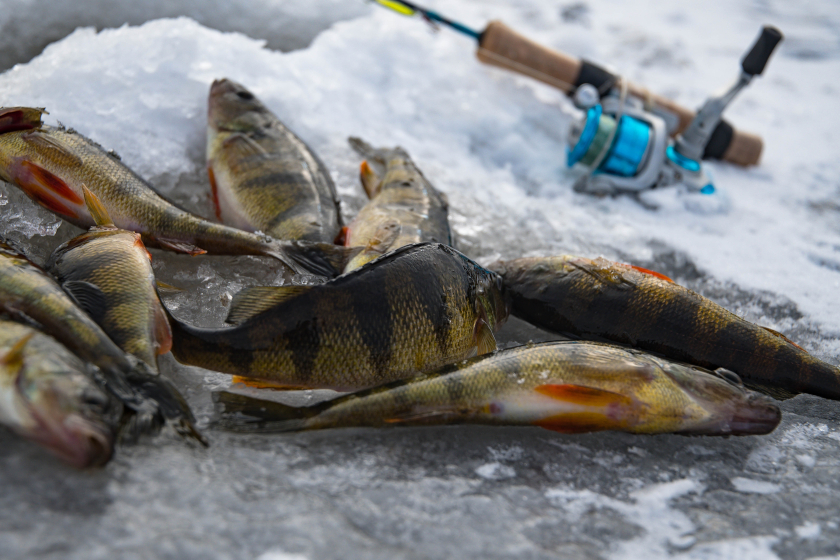
Getty Images: michaldziki
Many anglers are a little too aggressive in their presentations to perch. If you're working your bait or lure a little too fast, the perch may not show any interest in it at all. Work it too slowly and you may never catch their attention in the first place. It may take some trial and error to figure out exactly how the fish are responding to your presentations. This is yet another reason why electronics are so important for catching perch. You can quickly fine-tune things on the fly if you're watching the fish respond on a flasher or via an underwater camera. Especially when the fish are deep water.
Keep in mind that perch can often be scattered all over the lake in the winter months. And they may not all be feeding on the same thing either. One group on one end of the lake may be chowing down on your soft baits deep in the water column while on the other side spoons in the shallows are the only thing that will produce. It helps to have more than one rod rigged up with different lures and presentations.
Some anglers prefer a deadstick style of presentation where they've got a lure in a hole that's being worked very little. Don't be afraid to experiment when it comes to targeting perch through ice. The best anglers use the power of observation to tell them what to do next. It's not a bad idea to watch what the other anglers are doing either. If one guy has a pile of fish on the ice and the other has nothing, it might be worth asking to see what he's doing differently. Usually, it's something incredibly subtle with the presentation.
Ice fishing for perch is one of our favorite ways to beat the winter blues every year. Give it a try this season and you'll see why so many anglers love this time of year!
For more outdoor content from Travis Smola, be sure to follow him on Twitter and check out his Geocaching and Outdoors with Travis YouTube channels.
NEXT: ICE FISHERMEN LAND MULTIPLE 2+ YELLOW PERCH ON IDAHO'S CASCADE LAKE
WATCH
